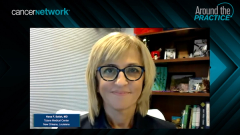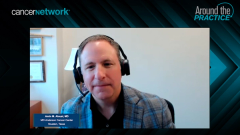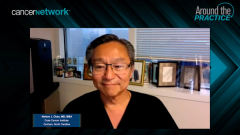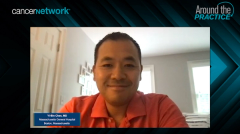
Armamentarium for Graft vs Host Disease Prophylaxis
Hematologist/oncologists provide a broad overview of the pharmacologic agents used to prevent graft vs host disease at their institutions.
Episodes in this series

Transcript:
Yi-Bin Chen, MD: I think the advent of novel strategies to prevent graft versus host disease [GVHD], as we will talk about posttransplant high-dose cyclophosphamide, has been somewhat of a leveling agent across the field for bone marrow donors. As we all know, and as many of the audience know, every recipient who undergoes an allogeneic transplant receives some form of prophylaxis against acute and chronic graft versus host disease. The 2 general categories are pharmacological¾ which means a combination of drugs, and that’s the most common because of how easy it is to do¾ and the second is a sort of laboratory manipulation of the graft itself called T-cell depletion, and their other novel forms of graft manipulation that are being researched and studied. We are going to focus a bit more on the pharmacological agents, as those are the most popular these days. I will share that at our institution, Massachusetts General Hospital in Boston, the standard for graft versus host disease prevention for well-matched conventional donors¾ so that’s related sibling or match unrelated donor¾ remains the combination of calcineurin inhibitor. Calcineurin inhibitor is usually tacrolimus [Prograf] with a short course of methotrexate [Rheumatrex]. If there is any mismatch, we have shifted toward using posttransplant high-dose cyclophosphamide, which is given on days 3 and 4 and generally paired with tacrolimus and a short course of mycophenolate. That’s been our standard of care. We have acknowledged that there are ongoing studies, which we are awaiting for the outcomes of, comparing those 2 platforms. There are other studies that are adding agents to those platforms as well. Could I ask anyone here if your institution is doing different things for prophylaxis in those settings?
Amin M. Alousi, MD: Yes, Yi-Ben, at The University of Texas MD Anderson Cancer Center in Houston we’ve converted approximately 90% to 95% use of posttransplant cyclophosphamide on days 3 and 4, as you have alluded to, in combination with tacrolimus and a short course of mycophenolate mofetil. Apart from patients who have contraindications, or whom we believe to be at high risk for cyclophosphamide specific issues, that is our sole GVHD prophylaxis regimen at MD Anderson.
Yi-Bin Chen, MD: That’s a broad shift compared with, say, a decade ago. Nelson, what’s going on at Duke University in Durham, North Carolina?
Nelson J. Chao, MD, MBA: We are doing the same things you are. Standard is still calcineurin inhibitor [protein phosphatase-3] with methotrexate. We use posttransplant cyclophosphamide, although we started to move some of these nonhaploidentical patients as well, but we still have not made all of the post cell change.
Yi-Bin Chen, MD: Hana?
Hana F. Safah, MD: Same. We still work with match-related donors and very good match unrelated. We are using the calcineurin inhibitor and methotrexate as our standard, but, again, for the high-risk patients, we are using the posttransplant time. As you said earlier, not every patient can get the posttransplant cyclophosphamide if he/she has high risk, whether it’s hemorrhagic cystitis or viral activation. However, it is gaining momentum, and we are using it more and more in certain patients.
Yi-Bin Chen, MD: I should mention that we had our first approval in GVHD prevention in the fall. That was abatacept [Orencia] for unrelated donor transplant in combination with tacrolimus and methotrexate. We haven’t used it much, mainly because the differences appear to be driven by the mismatch unrelated donors and we use posttransplant cyclophosphamide for that setting. We are understanding how it is being studied now, and we are prolonging the course of it to see if it can help prevent chronic graft disease [CGD] versus chronic host disease [CHD]. Is there a single novel platform that is of keen interest at your centers that you think will make a difference going forward?
Amin M. Alousi, MD: I think establishing whether posttransplant cyclophosphamide is better than conventional. Hopefully we will start to see data coming out to support that. I know that extensive analysis at our center, just comparing outcomes, suggests that to be the case.
Nelson J. Chao, MD, MBA: Can I ask what those numbers look like and what your experience has been so far? It sounds as though you are pretty gung-ho on this.
Amin M. Alousi, MD: Across all donor types¾ match sibling, match unrelated, mismatch unrelated and haploidentical¾our rates of severe acute GVHD have fallen into the single digits, somewhere closer to 5% then to 10%. Historically, as you know, those numbers have been approximately 15% to 20% with conventional GVHD prophylaxis, so that’s stage III, grade 3 and 4 acute GVHD. Our chronic rates are certainly less than 25% when bone marrow is used. When peripheral blood is used, we are still seeing chronic GVHD requiring systemic therapy of approximately 30%, which is lower than historical data too, provided you aren’t using another form to mitigate against that….
Yi-Bin Chen, MD: I think that it’s interesting how over the past decade, we have all¾in general, at least here in the US¾ moved away from polyclonal anti–T-cell globulins such as ATG [antithymocyte globulins]. Europe is a different story. They haven’t approved a product with ATLG [anti-T lymphocyte globulin] based on their phase 3 trials. I mentioned an abatacept study.
I totally agree with you, Amin, I think we definitely need to see the results of these studies that are comparing the PT cyclophosphamide platform with the calcineurin inhibitor with methotrexate. I think that’s a huge point of clarity for the field. I think we are all waiting to see that. I’ll mention that at our center, Massachusetts General Hospital, we are excited about the Orca-T platform of cell sorting. This uses graft manipulation as a way to prevent GVHD, and they are planning a phase 3 trial at some point going forward. I think others are excited about this too. This uses what we know/will talk about in terms of JAK [Janus kinase] inhibitors, and how they can be added to either platform, whether it be tac-methotrexate or posttransplant cyclophosphamide.
Transcript edited for clarity.
Newsletter
Stay up to date on recent advances in the multidisciplinary approach to cancer.























































































